| << Chapter < Page | Chapter >> Page > |

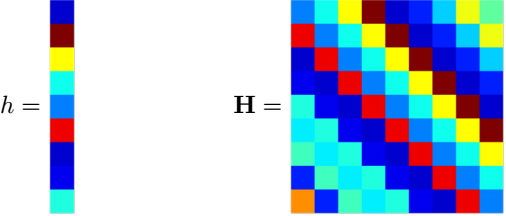
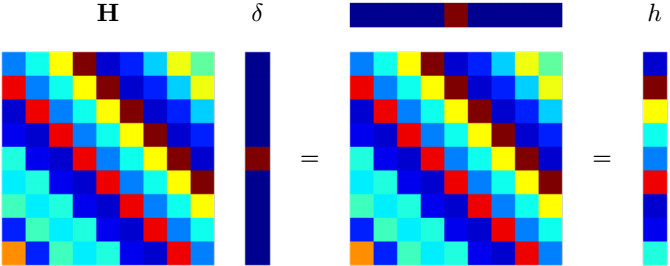
Because the impulse response is simply a column (specifically, the 0th column) of the system matrix $H$, then if $H$ is an LTI system, the impulse response completely characterizes the system. It tells us absolutely everything we need to know about the system! Why is this? Because we can construct the entire system matrix $H$ by simply shifting the impulse response accordingly. The value of the matrix at row $n$ and column $m$ is simply $h[n-m]$.
As a result, we can also express the system input-output matrix multiplication in terms of the impulse response. If we have that $[{\bf H}]_{n,m}$ is the value of the $H$ matrix at row $n$ and column $m$, then the matrix multiplication $y[n]=Hx=\sum_\limits_{m=-\infty}^{\infty}[{\bf H}]_{n,m}x[m]$. From above we have the matrix values expressed in terms of the impulse response; subbing this in we see the output is a sum involving the impulse response and the input: $y[n]=Hx=\sum_\limits_{m=-\infty}^{\infty}h[n-m]x[m]$.
Let's find the impulse response of a simple scaling system:
$y[n]=H\{x[n]\})=2x[n]$
To find the impulse response $h[n]$, simply calculate the output when the input is a delta function:
$h[n]=H\{\delta[n]\})=2\delta[n]$
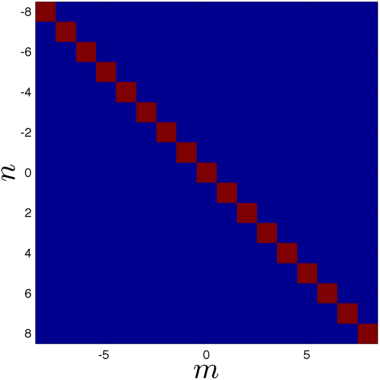
Now let's try finding the impulse response of a simple time-shifting system:
$y[n]=H\{x[n]\}=x[n-2]$
Once again, find the impulse response by giving a delta function as the input:$h[n]=H\{\delta[n]\}=\delta[n-2]$
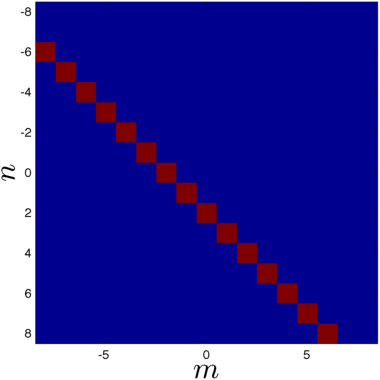
Consider now a simple moving average system:
$y[n]~=~ {\cal H}\{ x[n] \} ~=~ \frac{1}{2}\left( x[n]+x[n-1]\right)$For this system, we find that the impulse response is:
$h[n]~=~ {\cal H}\{ \delta[n] \} ~=~ \frac{1}{2}\left( \delta[n]+\delta[n-1]\right)$
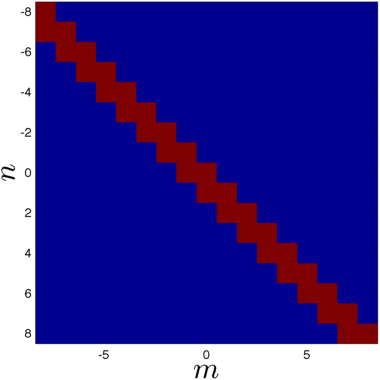
A recursive moving average system has the following input-output relationship: $y[n] ~=~ {\cal H}\{ x[n]\} ~=~ x[n] + \alpha\, y[n-1]$. To find the impulse response of this system, we first let $x[n]=\delta[n]$ and find the output:
$h[n]={\cal H}\{ x[n] \}+\alpha\, h[n-1]$
A bit more work is required if we would like a non-recursively defined impulse response. Assuming that the system $H$ is initially at rest (it has no output in the absence of an input), then we can find the output by computing several values of $h[n]$:
$h[-1]=0$
$h[0]=\delta[0]+\alpha h[-1]=1+\alpha \cdot 0=1$
$h[1]=\delta[1]+\alpha h[0]=0+\alpha\cdot 1=\alpha$
$h[2]=\delta[2]+\alpha h[1]=0+\alpha\cdot \alpha=\alpha^2$
Having discerned a pattern we have that $h[n]=\alpha^n u[n]$ (this may be more rigorously proven by induction, if desired):

As a result, the entire system matrix can be expressed in terms of the 0th column of the matrix, which (as with infinite length systems) is given the mathematical expression $h[n]$ and is named the impulse response. For a length $N$ LTI system, the formula to determine the value of the matrix at a particular row $n$ and column $m$ is $[{\bf H}]_{n,m} ~=~ h[(n-m)_N]$. Note how this is nearly identical to the infinite length formula, except for the modulo-$N$ operator.
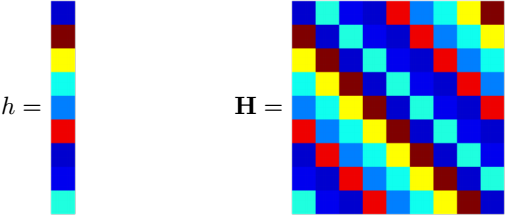

Notification Switch
Would you like to follow the 'Discrete-time signals and systems' conversation and receive update notifications?